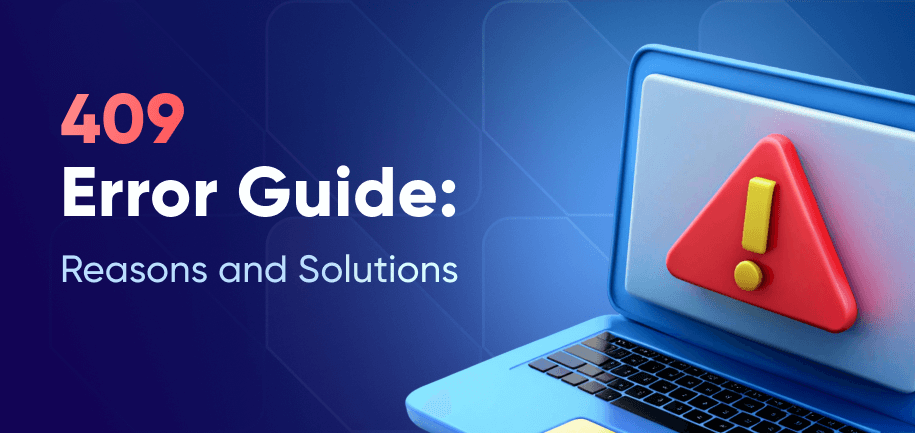Classified as a client-side error under the HTTP response status codes, the 409 Conflict error has become increasingly common, often disrupting user experience and compromising data consistency. It can be triggered by duplicate submissions, version control issues, or conflicting resource states – and knowing the root cause is key to solving the error.
Effective troubleshooting or QA and testing can help identify potential 409 conflicts early, minimizing disruptions. In this article, we’ll explore the common scenarios that cause the 409 Conflict status code and provide actionable strategies to prevent and resolve it effectively.
What is a 409 Conflict Error?
The HTTP 409 Conflict error indicates that a request made to a server cannot be completed due to a conflict with the current state of the resource. Unlike other errors caused by a lack of permissions or a missing target resource, the 409 error arises when the client and server have crossed wires, usually because of conflicting updates or concurrent modifications.
Imagine a user updating a product's details in the backend system. If another team member is editing the same product at the same time, they both will encounter a 409 Conflict error. The server detects a conflict between the changes and prevents the update from being saved.
How Error 409 Affects User Experience and Workflow
While the 409 error prevents data loss, its disruptive nature can slow down workflows and lead to inefficiencies. Here's how these errors might affect your operations if left unattended:
- Damage Reputation – Frequent error messages in SaaS solutions lead to user dissatisfaction, create a negative perception, and impact customer retention, ultimately affecting market competitiveness.
- Disrupt User Journeys – In your in-house solutions, 409 error can cause frustration and hamper collaboration, leading to inefficiencies and reduced productivity of your in-house teams.
- Challenges for Web Admins and/or Developers – Errors waste resources, cause data inconsistencies, increase operational costs, and limit scalability. All this slows down development and affects long-term goals.
So should you strive to minimize 409 errors in the software your teams or customers use? Absolutely.
Common Causes of 409 Conflict Errors
To effectively resolve and prevent the HTTP 409 error, you should first know and understand its possible causes. Here are the main factors that contribute to these errors:
Concurrency Issues
One of the primary drivers of the 409 error code is concurrency problems. When multiple users or systems attempt to access, modify, or update a resource simultaneously, it can lead to HTTP conflicts.
A common 409 status code example is when two users attempt to edit the same document at the same time, leading to overlapping changes that the server cannot reconcile automatically.
Version Control Conflicts
Version control conflicts are another widespread cause of the 409 error. When multiple versions of a resource are updated without proper synchronization, a conflict arises. A classic example is a content management system where authors attempt to update different versions of a page without resolving version discrepancies.
Resource Constraints
Server capacity limits or API rate thresholds can trigger 409 status code responses, especially during peak traffic or intensive backend operations. When multiple requests exceed what your server can handle, conflicts are more likely to occur.
If you’re running a Magento store, resolving the server-related issues doesn’t have to be a headache. Amasty’s server configuration and migration are designed to optimize performance, reduce 409 conflicts, and ensure your infrastructure scales smoothly with your store’s growth.
How to Resolve 409 Conflict: Step by Step
When a 409 response code interrupts your operations, applying targeted solutions can restore your system's functionality. Here’s a detailed guide to help you and your visitors address these conflicts effectively:
1. Clear Caches
To resolve issues caused by outdated data, clear caches on both the browser and server side. This action ensures you access the most recent versions of resources, which reduces discrepancies. Regular cache maintenance helps prevent conflicts and boosts performance.
2. Roll Back On-Site Changes
If you or your users encounter 409 conflicts, consider rolling back recent updates to identify the source. Reverting to a previous stable state can highlight problematic changes. This approach offers a clear path to integrate updates gradually without errors.
3. Update Server Configurations
Ensure server configurations are up to date to avoid unnecessary conflicts. Proper settings prevent path errors and resource misallocation. Regular server audits ensure alignment with your operational needs, which reduces the risk of 409 errors.
4. Disable Problematic Plugins or Code
Identify and disable problematic plugins or scripts to tackle conflicts in requested resources. Incompatible or outdated code often disrupts your operations. Carefully analyze and test to pinpoint and resolve these issues, improving your system's stability.
5. Implement Locking Mechanisms
Use locking mechanisms to manage access conflicts and ensure that only one process can modify a resource at a time. You can lock the resource during access to prevent others from making simultaneous changes. This will help reduce the likelihood of 409 Conflict errors in high-traffic environments.
If implementing these fixes on your e-commerce store feels overwhelming, our managed services are here to help. We provide expert assistance with cache and update management, server configurations, code and plugin audits, and access control. Our team will ensure your store runs smoothly, minimizing errors and optimizing performance.
409 Conflict Resolution: Advanced Techniques
With advanced techniques to resolve 409 errors, you can enhance your application's efficiency and reliability. Here are some effective methods:
Optimistic Concurrency Control (OCC)
Unlike pessimistic locking, described in point 5 of the previous section, optimistic locking allows multiple users to access resources simultaneously without immediately imposing limitations.
Instead of locking the resource, the system checks for conflicts during the update process. If a conflict arises, the user receives a notification to reconcile changes, preventing disruptions and maintaining data integrity. OCC lets you benefit from:
- Reduced Locking – Resources remain accessible, improving performance.
- Proactive Conflict Management – Issues are resolved only when they occur, targeting specific challenges.
- Enhanced User Experience – Users can proceed without delays since resources aren't immediately locked.
- Scalability – Supports a larger number of simultaneous operations without degrading system performance.
Versioning Strategies
Version control is key to managing updates of the same resource from multiple users. These systems track changes and maintain a history of modifications. Such an approach enables users to merge updates efficiently and resolve conflicts, ensuring a seamless collaborative experience and consistent data management. With versioning strategies, you can enjoy:
- Comprehensive Audit Trails – Track every change for accountability.
- Smooth Collaboration – Facilitate easy merging of concurrent updates.
- Data Reliability – Access to historical versions ensures data recovery if needed.
- Conflict Resolution Tools – Built-in features simplify the process of addressing conflicting updates.
Best Practices for Preventing 409 Errors
Preventing 409 errors requires implementing strategic measures to handle resource conflicts effectively. Here’s how you can reduce the risk:
Tools for Conflict Detection and Resolution
Use monitoring platforms like New Relic and Datadog for real-time insights into system performance and early detection of potential conflicts. To manage data access, rely on databases like PostgreSQL and MongoDB, which ensure consistency and reduce the likelihood of conflicts. Also, implement version control systems such as Git or SVN to track changes and coordinate updates across multiple users.
Synchronization Mechanisms
To avoid issues caused by unsynced changes or simultaneous updates, apply synchronization strategies at both the server and application levels:
- Server and Database Protocols. Implement protocols that ensure resources are consistently updated, reducing the risk of conflicting modifications.
- Real-Time Data Sync. Utilize tools that synchronize data in real-time, keeping all users and systems aligned and minimizing discrepancies.
Server-Side Automation and Scaling Solutions
Leverage cloud platforms like AWS and Azure, which offer dynamic resource management tools to help prevent 409 errors. Their key features include:
- Load Balancing. Evenly distribute incoming traffic across servers to avoid overload and maintain consistent performance during peak usage.
- Auto Scaling. Automatically adjust server capacity in response to real-time demand, ensuring sufficient resources to support concurrent access without conflicts.
- Automated Monitoring. Continuously track server performance to detect potential bottlenecks early and resolve issues before they escalate.
Key Insights on Handling 409 Errors
Facing a 409 Conflict error can be challenging, but it’s manageable with the right approach. Understand the causes, apply the solutions from this guide, and prevent these errors from disrupting your operations in the future. Consider OCC and versioning practices that will help you maintain system efficiency and ensure a great user experience.
Still having troubles with 409 errors? Feel free to contact Amasty's QA experts for personalized support and solutions tailored to your specific needs.


















